Mauryan polish
Mauryan polish describes one of the frequent characteristics of architecture and sculptures of the Maurya Empire in India (325 to 185 BCE), which gives a very smooth and shiny surface to the stone material, generally of sandstone or granite.[1] Mauryan polish is found especially in the Ashoka Pillars as well as in some constructions like the Barabar Caves. The technique did not end with the empire, but continued to be "used on occasion up to the first or second century A.D.",[2] although the presence of the polish sometimes complicates dating, as with the Didarganj Yakshi. According to the archaeologist John Marshall: the "extraordinary precision and accuracy which characterizes all Mauryan works, and which has never, we venture to say, been surpassed even by the finest workmanship on Athenian buildings".[3]
| Mauryan polish | |
|---|---|
 The Lion Capital of Ashoka from Sarnath, one of the finest examples of Mauryan polish. | |
| Material | Polished sandstone |
| Period/culture | 3rd Century BCE |
| Place | India. |
Polished Barabar Caves
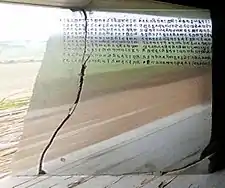

The Barabar caves are the first known and dated example of Mauryan polish, since they were dedicated by Ashoka in several inscriptions, in the year 12 and the year 19 of his reign. The caves were carved out of granite, an extremely hard rock, then finished with a very nice polishing of the inner surface, giving a mirror effect of a great flatness, as well as an echo effect. [5] [4] This large-scale polish directly evokes polishing on smaller surfaces of the Maurya statuary, particularly visible on the pillars and capitals of the Pillars of Ashoka.
This know-how seems to have disappeared again after the Maurya period, none of the subsequent caves such as the Ajanta Caves having this characteristic of polished surfaces [6][7]
At Barabar Caves, some caves where dedicated through inscription by Ashoka (the caves of the Barabar group), as well as by his grandson and successor Dasaratha Maurya (the caves of the Nagarjuni group). Both group of caves have perfectly polished walls, which suggest that polishing techniques were not exclusive to Ashoka, and continued as least for some time after his reign.
- Later Caves
After the Barabar Caves, the polishing of cave walls was abandoned, never to be revived, despite the huge efforts at building Buddhist and Jain caves until the 6th century CE. Such grandiose caves as Karla Caves (1st century CE) or the Ajanta Caves (5th century CE) do not have any polishing either. This may be due to the fact that Mauryan caves were dedicated and sponsored by the Mauryan Imperial government, allowing for huge resources and efforts to be spent, whereas later caves where essentially the result of donations by individuals, who could not afford as high a level of spending.[8]
Pillars of Ashoka

The pillars of Ashoka, made of sandstone, generally also exhibit a high level of Mauryan polish. Here again the mirror-like polish has generally been considered as an import from the Near-East, but some authors now consider the Son Bhandar Caves might constitute a precedent and an evolutionary step to this type of polish, although these caves are generally dated to a much later period (2-4th century CE).[9]
The pillars
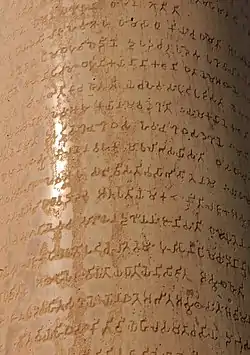
All known Mauryan pillars have the characteristic mirror-like polish, although most were left unpolished over the surface of the bottom part meant to be buried in the ground.[10]
Inscriptions were made over the polished finish, with the ungainly result that the polished stone is chipped around the letters. Normally, the text should be inscribed first, and only then should the stone be polished if a good result is to be obtained. This tends to suggest that the inscriptions were made as an afterthought, after the pillar has been properly completed.
The capitals
Some of the capitals of the pillars of Ashoka exhibit mirror-like polish (such as the Sarnath and the Sanchi capitals), while other don't and only have a smooth surface (the Sankissa capital or the Rampurva bull elephant). This, together with epigraphical considerations, has even led some authors to question if these non-polished capital might be of a time prior to Ashoka.[11]
These non-polished pillars are also those that displays the highest level of Hellenistic influence: in the case of the Rampurva bull or the Sankassa elephant, the abacus is composed of honeysuckles alternated with stylized palmettes and small rosettes.[12] A similar kind of design can be seen in the frieze of the lost capital of the Allahabad pillar. These designs likely originated in Greek and Near-Eastern arts.[13]
 Sankissa elephant. Non polished.
Sankissa elephant. Non polished.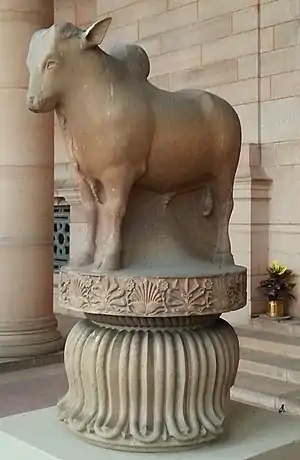
 Rampurva lion. Polished.
Rampurva lion. Polished. The "Lion Capital of Ashoka", from Sarnath. Polished.
The "Lion Capital of Ashoka", from Sarnath. Polished.
Mauryan statuary

There are many examples of polished stone statuettes and artifacts from the Mauryan period. One of them, the Masarh lion, discovered near Patna, is special in that its style is nearly completely Achaemenid, which suggests a high level of artistic influence from Western Asia at the time the statuette was made.
The Masarh lion, discovered near Pataliputra and dated to the 3rd century BCE, is carved in sandstone of the Chunar type, like the Ashoka Pillars, and its finish is polished.[1] The sculptural style is also indisputably Achaemenid [1] This is particularly visible with the well-ordered tubular representation of whiskers (vibrissas), and the geometrical representation of inflated veins flush within the whole face.[1] The mane on the other hand, with the tufts of hair represented in ripples, is rather naturalistic.[1] According to SP Gupta, these stylistic characteristics can be described as non-Indian.[1] Very similar examples of sculptures are known in Greece and in Persepolis.[1] It is possible that this sculpture was made by an Achaemenid or Greek sculptor in India and either remained without effect, or was the Indian imitation of a Greek or Achaemenid model, somewhere between the 5th and the 1st century BCE, although it is generally dated from the time of the Maurya Empire, around the 3rd century BCE.[1]
According to John Boardman, the lion sculpture of Marsarh is "quite Persian", although the treatment of the mane is rather of Greek naturalistic style and breaks with the rigid and codified style of the Achaemenid Empire.[14] For him, the lions of the Lion Capital of Ashoka at Sarnath represent the next logical and artistic step, and would be the realization of Hellenistic Greek artists to soften and give more naturality to Persian style.[14]
There are also a few examples of polished statuary, all dated to the Mauryan period, such as the polished sculpture of a head from Sarnath.
The Diamond throne of Bodhgaya is another example. It was established by Ashoka at Bodh Gaya and also exhibits the characteristic Mauryan polish.[15]
Polished ringstones are variously said to be Mauryan or Sunga, dating ranging for the 3rd c.BCE to the 1st c.BCE.[16]
 The Masarh lion, another example of Mauryan polish. A modern photograph .
The Masarh lion, another example of Mauryan polish. A modern photograph .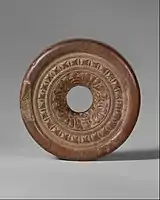 Polished ringstones are variously said to be Mauryan or Sunga, dating ranging for the 3rd c.BCE to the 1st c.BCE.[16]
Polished ringstones are variously said to be Mauryan or Sunga, dating ranging for the 3rd c.BCE to the 1st c.BCE.[16] Polished sculpture of a head, Sarnath, Maurya period.
Polished sculpture of a head, Sarnath, Maurya period. The polished surface of the Diamond throne.
The polished surface of the Diamond throne.
Didarganj Yakshi
The Didarganj Yakshi is generally considered as one of the finest examples of Mauryan art.[17][18][19][20][21][22][23] Alternatively, it is rather dated to the 2nd century CE, based on the analysis of shape and ornamentation. According to some art historians, the treatment of the forelock in particular is said to be characteristically Kushan.[24]
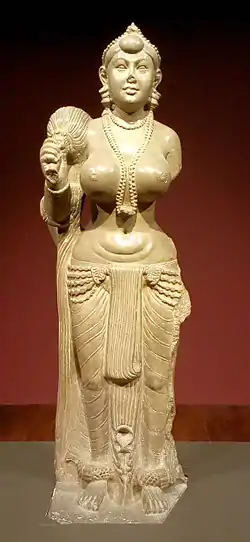
Post-Mauryan near abandonment of polishing techniques
After the Mauryan period, the general sculptural trend is towards the complete abandon of polishing techniques. This may be due to the high cost involved with polishing. The end of the Mauryan period marked the end of imperial patronage of the arts, which thereafter tended to be financed by the people or the wealthy merchant class thereafter.[25] There are however a few important cases of polishing that seem to subsist.[26]
The Parkam Yaksha "Manibhadra" is made of polished grey sandstone, in the same material as the Pillars of Ashoka. This statue is generally dated to the 3rd-1st centuries BCE, and may be immediately post-Mauryan.[26] It may be a transitional from the Mauryan period to next period including the reliefs of Bharhut, presenting some continuity in the finishing technique, but a real fracture in terms of sculptural style.[26]
The Didarganj Yakshi, although claimed by some as an example of Mauryan art[27] is generally dated to the 2nd century CE, based on the analysis of shape and ornamentation.[28][29][22] This life-size standing image is tall, well-proportioned, free-standing sculpture is made of sandstone with well polished surface.[30] This statue, if the 2 century CE date is upheld, would suggest that polishing technique in fact did not disappear with the Mauryas, but remained in India, and was simply little used, possibly because of the high labor and cost involved.
 Reliquaries discovered at Piprahwa stupa, 2nd century BCE.
Reliquaries discovered at Piprahwa stupa, 2nd century BCE. The Parkam Yaksha "Manibhadra", polished grey sandstone, same material as Ashoka pillars. 3rd-1st centuries BCE, possibly immediately post-Mauryan.[26]
The Parkam Yaksha "Manibhadra", polished grey sandstone, same material as Ashoka pillars. 3rd-1st centuries BCE, possibly immediately post-Mauryan.[26] Shiva standing on Apasmara, carved on a lingam, Gudimallam, 1st-2nd century BCE. Polished stone.[31]
Shiva standing on Apasmara, carved on a lingam, Gudimallam, 1st-2nd century BCE. Polished stone.[31]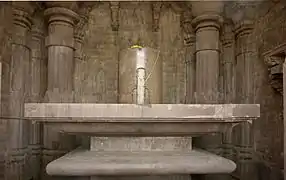 Bhojpur temple linga 11th century AD
Bhojpur temple linga 11th century AD_(13926412196).jpg.webp) polygonal Lingam in shore temple 8th century
polygonal Lingam in shore temple 8th century.jpg.webp) Hazararama temple polished granite pillar hampi 15th century
Hazararama temple polished granite pillar hampi 15th century Ellora cave 15 polished nandi 8th-10th century AD
Ellora cave 15 polished nandi 8th-10th century AD Pala dynasty 12th century
Pala dynasty 12th century
Debate on Achaemenid vs Pre-Mauryan origins

Achaemenid sculptural art was often characterized by a great level of polishing of the stone (usually sandstone, a very hard material), and it is thought that this polishing influenced the Maurya polishing, as is visible in the architecture of the columns of Pataliputra.[32][33] Sandstone is very hard to work, so it is believed that polishing was obtained by the use of emery grains (Mohs hardness index 8) from Naxos and Armenia.[34] Stones and polishing grains have been found in the ruins of Persepolis.[34] These polishing techniques were also used by the Greeks, who used the natural Naxos emery grains.[35]
It is believed that the stone-making techniques employed by the Mauryas may have derived from the techniques of Achaemenid statuary, stone-working and polishing techniques having spread to India after the destruction of the empire by Alexander the Great in 330 BCE and the displacement of Persian and Perso-Greek artists and technicians.[6]
 Lion Fragment, Persepolis, Iran. Sandstone. 550-330 BCE.
Lion Fragment, Persepolis, Iran. Sandstone. 550-330 BCE. Achaemenid feline, Persepolis, 486-465 BCE
Achaemenid feline, Persepolis, 486-465 BCE Achaemenid sculpture, Persepolis, 486-465 BCE
Achaemenid sculpture, Persepolis, 486-465 BCE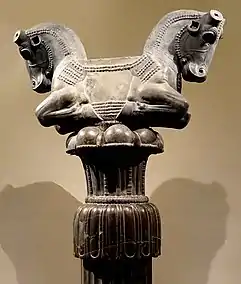 Highly polished Achaemenid capital.
Highly polished Achaemenid capital. Polished Achaemenid pillar capital (detail).
Polished Achaemenid pillar capital (detail).
According to Gupta, the polishing of rocks could have a local origin. He invokes the existence of polishing technologies of the neolithic, visible in various stone tools such as axes. There is, however, no trace of evolution from these neolitical tools to polished stone architecture, and the Barabar caves are essentially a sudden technological break with no local history, suggesting the import of these techniques from another culture. Nor are there any known examples of stone architecture in India before the Maurya period.[36] According to Gupta, the Son Bhandar Caves could be such an intermediate stage, relatively unique, and subject to questioning its chronology, since it is generally dated to the 2nd-4th centuries CE.[36] The polish was achieved by application of agate burnisher which was later applied on pillars and sandstone objects.[37][38] Some examples of Indus Valley Civilisation statuary (Harappa, Mohenjo-Daro, circa 3000-2000 BCE) do show a certain level of polishing.[39][40]
Pataliputra Voussoir fragment made of graite stone discovered by K. P Jayaswal had mauryan polish but was dated to pre Mauryan Nanda period due to three archaic brahmi letters which paleographically appeared before mauryan period Brahmi. The voussoir has been analysed to be part of trefoil arch which decorated a torana gate.[41][42][43]
 Polished stone ax, India, 2800 BCE-
Polished stone ax, India, 2800 BCE- Son Bhandar Cave with some polish, 2nd-4th centuries CE. Possibly pre-Mauryan according to Gupta.
Son Bhandar Cave with some polish, 2nd-4th centuries CE. Possibly pre-Mauryan according to Gupta.
 Mohenjo-daro priest king polished statue.[39]
Mohenjo-daro priest king polished statue.[39]
See also
References
- The roots of Indian Art, Gupta, p .88
- Harle, 24
- The Early History of India by Vincent A Smith
- Ashoka in Ancient India by Nayanjot Lahiri p. 231
- Michell 1989.
- Maharashtra, Marg Publications, 1985, p. 209 Pdf p. 2 "The surface of the inside walls are polished to a mirror-like finish, an exclusive characteristics of Mauryan architecture and sculpture, first derived through the media of Achamenid art after the disintegration of the Persian Empire in AD 330 and the dispersal of skilled Persian and Perso-Greek artisans "
- Indian History p. 268
- Le Huu Phuoc, Buddhist architecture, p.99
- Buddhist Architecture, Le Huu Phuoc, Grafikol, 2009, p.45
- Le Huu Phuoc, Buddhist Architecture, p.36
- John Irwin, "The true chronology of Ashokan pillars", p.147
- Le, Huu Phuoc (29 October 2017). Buddhist Architecture. Grafikol. ISBN 9780984404308. Retrieved 29 October 2017 – via Google Books.
- Le, Huu Phuoc (29 October 2017). Buddhist Architecture. Grafikol. ISBN 9780984404308. Retrieved 29 October 2017 – via Google Books.
- The Origins of Indian Stone Architecture, 1998, John Boardman p.18.
- The Origins of Indian Stone Architecture, 1998, John Boardman pp. 13-22.
- Gupta, The Roots of Indian Art, p.53
- Chatterjee, Partha; Ghosh, Anjan (2006). History and the Present. Anthem Press. ISBN 9781843312246.
- Ganguly, Keya (2010). Cinema, Emergence, and the Films of Satyajit Ray. University of California Press. ISBN 9780520262164.
- Kumar, Amitava (2014-03-10). A Matter of Rats: A Short Biography of Patna. Duke University Press. ISBN 9780822376453.
- "A History of Ancient and Early Medieval India: From the Stone Age to the 12th Century" by Upinder Singh, Pearson Education India, 2008
- ""Ayodhya, Archaeology After Demolition: A Critique of the "new" and "fresh" Discoveries", by Dhaneshwar Mandal, Orient Blackswan, 2003, p.69
- "A Companion to Asian Art and Architecture" by Deborah S. Hutton, John Wiley & Sons, 2015, p.435
- Huntington, John C. and Susan L., The Huntington Archive - Ohio State University , accessed 30 August 2011.
- Pereira, Jose (2001). Monolithic Jinas. Motilal Banarsidass. p. 11. ISBN 9788120823976.
- Le Huu Phuoc, p.45
- Smith, Vincent Arthur (2012). Art of India. Parkstone International. p. 43. ISBN 9781780428802.
- Chaudhary, Pranava K (28 September 2006). "A fortress chockfull of chinks". Indiatimes. Retrieved 17 February 2011.
- "A History of Ancient and Early Medieval India: From the Stone Age to the 12th Century" by Upinder Singh, Pearson Education India, 2008
- ""Ayodhya, Archaeology After Demolition: A Critique of the "new" and "fresh" Discoveries", by Dhaneshwar Mandal, Orient Blackswan, 2003, p.46
- "A History of Ancient and Early Medieval India: From the Stone Age to the 12th Century" by Upinder Singh, Pearson Education India, 2008 p.364
- Coomaraswamy, Ananda Kentish (1927). History of Indian and Indonesian art. Dover Publications. p. 232.
- Sailendra Nath Sen's Ancient Indian History and Civilization p.118
- Foreign Influence In Ancient India, by Jairazbhoy, Publication date 1963 p.45
- "The extremely hard emery of Armenia, which was under the Achaemenid hegemony, seems to be the closest natural source for polishing the Persepolis, Pasargadae, and Susā royal palace stones" Hunt, 2008 in "Tectonic Evolution, Collision, and Seismicity of Southwest Asia, Rasul Sorkhabi p.33
- "For efficient polishing, Greeks used emery (Mohs 8) from the rich deposits of the Cycladic island of Naxos." in A Companion to Greek Art, published by Tyler Jo Smith, Dimitris Plantzos p.242
- Gupta, The roots of Indian Art, p.194-
- Brown, Percy (2013-04-16). Indian Architecture (Buddhist and Hindu Period). Read Books Ltd. ISBN 9781447498575.
- Devahuti, D. (1971). "MAURYAN ART AND THE "EPISODE" THEORY". Annals of the Bhandarkar Oriental Research Institute. 52 (1/4): 161–173. JSTOR 41688719.
- "...the "Priest-King's" head is so carefully tapered and polished." in Jansen, Michael; Mulloy, Máire; Urban, Günter (1991). Forgotten cities on the Indus: early civilization in Pakistan from the 8th to the 2nd millennium BC. Verlag Philipp von Zabern. p. 169. ISBN 9783805311717.
- Singh, Upinder (2008). A History of Ancient and Early Medieval India: From the Stone Age to the 12th Century. Pearson Education India. ISBN 9788131711200.
- The Calcutta University (1923). Proceedinds And Transactions Of The Second Oriental Conference (1923).
- Spooner, Brainerd (1924). Annual Report Of The Archaeological Survey Of India 1921-22.
- Chandra, Ramaprasad (1927). Memoirs of the archaeological survey of India no.30.
- Honour, Hugh; Fleming, John (2005). A World History of Art. Laurence King Publishing. p. 65. ISBN 9781856694513.
- Kleiner, Fred S. (2009). Gardner's Art through the Ages: Non-Western Perspectives. Cengage Learning. p. 11. ISBN 9780495573678.
- Harle, J.C., The Art and Architecture of the Indian Subcontinent, 2nd edn. 1994, Yale University Press Pelican History of Art, ISBN 0300062176